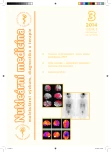Determination of cerebrovascular reserve using dipyridamole and brain SPECT
Authors:
Renata Píchová 1; Helena Trojanová 1; Tomáš Peisker 2
Authors‘ workplace:
Klinika nukleární medicíny, 3. LF UK a FN Královské Vinohrady, Praha
1; Neurologická klinika, 3. LF UK a FN Královské Vinohrady, Praha
2
Published in:
NuklMed 2014;3:45-50
Category:
Original Article
Overview
Introduction:
Cerebrovascular reserve is one of the important parameters for implementation and monitoring of neurosurgical intervention success in patients after ischemic stroke, transient ischemic attack, or to indicate the type of dementia.
Aim:
The aim of this paper is to inform about the implementation of dipyridamole vasodilator test as a possible alternative pharmacological stress, the incidence of side effects, the obtained results and its advantages and weaknesses.
Material and Methods:
A retrospective analysis of 20 patients (8 women and 12 men in the age range 37 to 78 years), 6 after transient ischemic attack, 14 after ischemic stroke, were examined during two years. Patients were scanned with gamma camera Infinia Hawkeye using fan beam collimators with SPECT technique, at first in a standard way under basal conditions and afterwards within 1–13 days after dipyridamole pharmacologic stress (by iv infusion at a dose of 0.84 mg/kg into 50 ml of F1/1 within 4 min) followed by i.v. injection of 99mTc-HMPAO in the 10th minute. Side effects of dipyridamole was recorded; Syntophyllin was used as an antidote. Differences in basal and post-stress studies were evaluated visually and semiquantitatively using NeuroGamTMSegami and Statistical Parametric Mapping.
Results:
Cerebrovascular reserve was normal in 9 patients (45 %), reduced in 11 patients (55 %). 8 patients (6 men, 2 women) with internal carotid artery occlusion (6 on right, 2 on left) were treated subsequently neurosurgically, 6 (75 %) of these patients were with pathological findings of cerebrovascular reserve, 2 (25 %) had normal cerebrovascular capacity. 12 remaining patients were treated conservatively, 5 (42 %) of these patients had pathological (mild reduce occurrence, complications preoperatively) and 7 (58 %) patients had normal cerebrovascular reserve.
Side effects of dipyridamole (hypotension, cough, chest tightness, headache) were recorded in 5 patiens; they decline within 2–5 minutes.
Conclusion:
Stress brain perfusion scintigraphy with dipyridamole administration is the appropriate test to assess vascular brain reserve. It is non-invasive, easily accessible and it contributes to the decision of neurosurgery.
Key Words:
cerebrovascular reserve, brain SPECT, dipyridamole, stroke
Sources
1. Mysliveček M, Kamínek M, Koranda P et al. Nukleární medicína. Olomouc.Univerzita Palackého v Olomouci, 2007,131 p
2. Lang O, Kamínek M., Trojanová H. Nukleární kardiologie. Praha, Galén, 2008, 130 p
3. Kupka K, Kubinyi J, Šámal M et al. Nukleární medicína. Příbram, P3K, 2007, 200 p
4. Hwang TL, Saenz A, Farrell JJ et al. Brain SPECT with dipyridamole stress to evaluate cerebral blood flow reserve in carotid artery disease. J Nucl Med 1996;37:1595-1599
5. Derdeyn CP, Grubb RL, Powers WJ. Indications for Cerebral Revascularization for Patients with Atherosclerotic Carotid Occlusion. Skull Base 2005;15:7–14
6. Šroubek J, Kovář M, Tomek A et al. Extra-intrakraniální bypass při uzávěru arteria carotis interna. Neurol pro praxi 2010;11:45–49
7. Schmiedek P, Piepgras A, Leinsinger G et al. Improvement of cerebrovascular reserve capacity by EC-IC arterial bypass surgery in patients with ICA occlusion and hemodynamic cerebral ischemiia. J Neurosurg 1994;81:236–244
8. Baert AL, Heuck FHW, Youker JE. Diagnostic Nuclear Medicine. Heidelberg, Springer, 2000, 296 p
9. Grubb RL, Derdeyn CP, Fritsch SM et al. Importance of hemodynamic factors in the prognosis of symptomatic carotid occlusion. JAMA 1998;280:1055–1060
10. Sasoh M, Ogasawara K, Kuroda K et al. Effects of EC-IC bypass surgery on cognitive impairment in patients with hemodynamic cerebral ischemia. Surg Neurol 2003;59:455–463
11. Garret MC, Komotar RJ, Merkow MB et al. The Extracranial-Intracranial Bypass Trial: implications for future investigations.Neurosurg Focus 2008;24:E4
12. Sameš M, Zolal A, Radovnický T et al. Použití metod magnetické rezonance pro posouzení cerebrovaskulární rezervní kapacity. Cesk Slov Neurol N 2009; 72/105: 323-330
13. Kalita Z. a kolektiv. Akutní cévní mozkové příhody. Praha, Maxdorf, 2006, 620 p
14. Hiroshi I, Toshibami K, Yoshikazu T et al. Effect of intravenous Dipyridamole on Cerebral Blood Flow in Humans, A PET Study. Japan. Stroke.1999;30:1616-1620
Labels
Nuclear medicine Radiodiagnostics RadiotherapyArticle was published in
Nuclear Medicine

2014 Issue 3
Most read in this issue
- Determination of cerebrovascular reserve using dipyridamole and brain SPECT
- Treatment of patient with accumulating skull metastases in thyroid cancer
- Quantification of cerebrovascular reserve in patients with cerebrovascular disease – is there still a role for scintigraphy?
- Differentiated thyroid cancers
